|
TOOL BAR |
The toolbar runs from left to right across the top of the Lucky Picks
screen. It is split into four main sections.

· On the left you have a group of two buttons which allow you to open
the Lucky Picks main screen; by default this screen is open on startup.
· The next button followed by the main icon is the 123 button which
allows you to view repeated occurrences of numbers.
· The next button is a calculator used to do mathematical calculations.
· The right button marked with a X allows you to exit the program.
 |
|
|
STATUS BAR |
At the bottom of the Lucky Picks screen you will see the Status Bar. There
are five sections to it.

|
- The left section displays the total draws of past winning
draws you have added to your database.
- The next section displays the last draw date you have entered into
your database.
- The next section is the History cut off point where you have
selected to be the hot point of a number.
- The next section displays the number of history lines you are
viewing.
- The next section is the processing indicator light. When it has
finish compiling it will turn from red to green.
- The right-hand section displays the date.
|
|
|
VIEW OCCURRENCES |
 View Occurrences button
View Occurrences button
You can view repeating sets by numbers of repeated Occurrences or
Neighboring numbers.
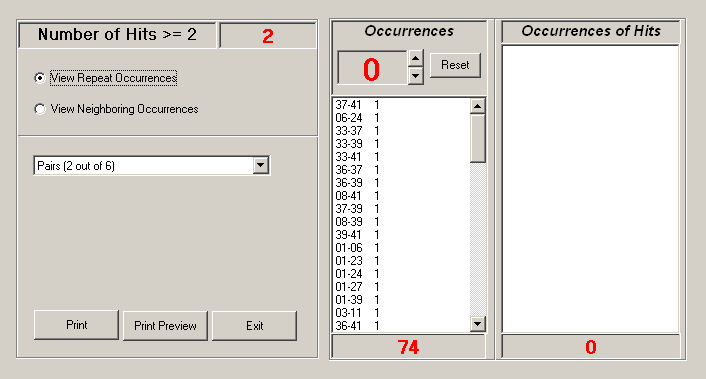
 |
|
| DRAWS |
The Add/Edit or Delete Draws option allows you to Add/Edit or Delete
numbers from the previous drawings for your lottery, and to keep the
data base file updated as new drawings occur. You should update your
lottery database file with the officially drawn numbers before using the
Check For Winning Games from the History tab option from the main
window. Numbers on the pad is displayed according to the lottery game
you wish to play. The following example is for Lotto 6/49.
Adding Draws:
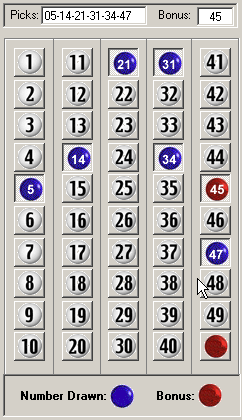 |
- Click on Clear button to clear entry from picks display window.
- Select the draw date for the officially drawn numbers.
- Click on the six officially drawn numbers from the number pad from 1
to 49. A total of numbers selected is display in the top right corner.
- Click on the red bonus button to enter the Bonus number.
- Click the Add button to save the entry.
The numbers selected are highlighted in Blue and the Bonus number is
in Red.
The program checks for invalid or duplicate numbers that are out of
range. It will not let you save a drawing until both the date and the
numbers drawn are correct. After you have entered all the numbers that
were drawn, including Bonus number, click on the Add Drawing button.
Edit Draws:
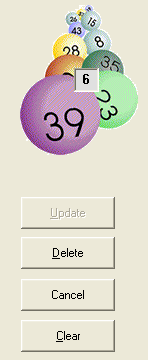
- Click on the row of the draw date you wish to edit.
- Click on the number(s) from the number pad you wish to change.
This will unselect the number.
- Click on the number(s) you want to select as part of the
officially drawn numbers.
- Click the Update button to save the entry.
Deleting Draws:
- Click on the row of the draw date you wish to edit.
- Click on the Delete button to delete the drawn entry.
- Confirm deletion Yes/No option.
 |
|
|
HISTORY |
The History tab option allows you to view and search past winning draws
and record winnings and losses.
Record Winnings:
Record winnings and losses from played games.
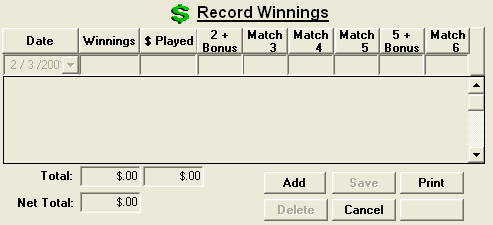
Ticket Search:
You can search a set of six numbers through the whole database by
selecting the New button allowing you to do your six number search or
you can specify the date you wish to do your search.
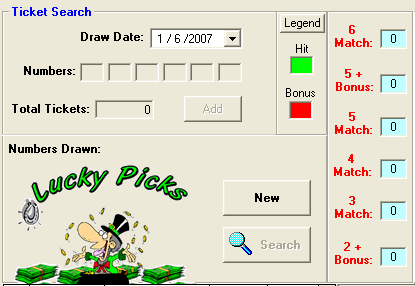
 |
|
|
STATISTICS |
Tracking number trends depends on your history selection which will help
you make an educated choice. The number trend chart shows the Frequency,
Hit Ratio, Hot, Cold, and Bonus numbers of individual numbers in the
lottery. Calculations are performed on all draws in the data base up to
and including the last draw, unless you change the History option in the
Statistics menu. If you reduce the value of History, then calculations
are performed only on the number of drawings that History is set to.
For example, if there are 200 drawings in the data base file, and
History is set to 100, only the last 100 drawings will be analyzed.
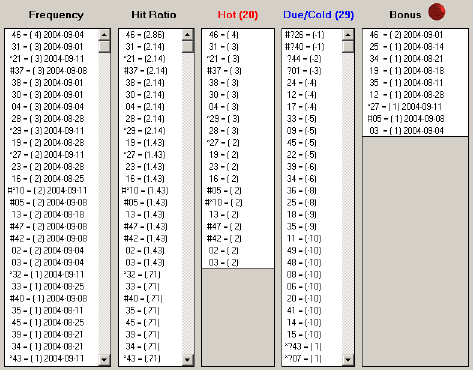
View the short cycle hits according to the history of numbers you are
viewing. To change the History or view past winning draws, click on the
Statistics Tab and change the number of past history lines you wish to
view.
View Statistics
Each draw is color coded up-to a max of six lines and you can view at
any past history draws. You will view how each number was drawn by it's
color. I have included the Hit Ratio and Frequency Hits according to the
history of lines you searched for to help you select a nice pool of
possible future draw numbers. You can double click on the number to add
to the list so you can wheel these numbers according to your wheel
selection.
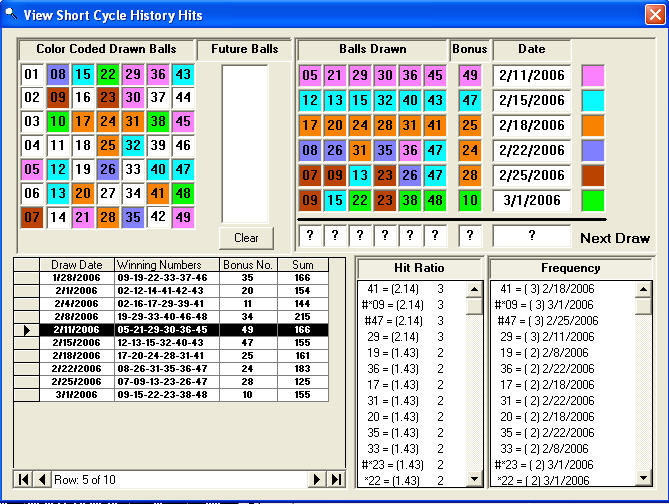
View Match Play
How to play Match Play:
There are times I like to play this method for Lotto Max. First I
buy a couple of quick picks of Lotto Max for the upcoming draw. If you
look at your tickets you would probably notice that some numbers are
played more than others and most likely they would not come out. If they
did you would win more than once. I'm not saying that it's not likely to
come out but the odds are very high.
- Enter each line ticket to the playing board
- After each ticket entered, it calculates each number for a match
- Next decided which numbers to play for your wheeling selection
(Hint: least hits)
Very simple! It gives an idea of what numbers not to play when
selecting a proper wheel.
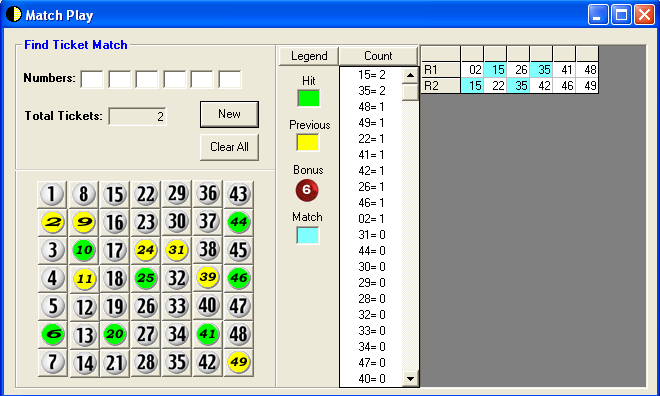
 |
|
|
HIT PERFORMANCE |
Summary draws shows the average and percentage of numbers within each
section and how many times it came out based on the history of past
draws you are viewing.
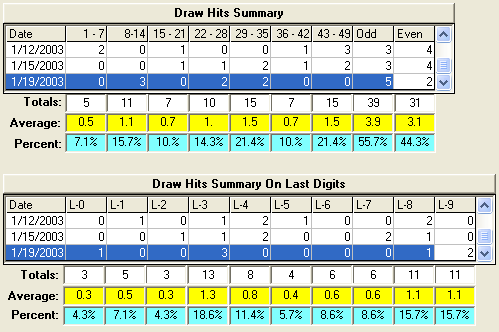
Some numbers in the lottery have appeared in a lot of different number
patterns or hit performance. This chart provides information about
individual numbers of performance. This is broken down by Hit Sequence,
Regular Draw Hits, Last Digit Totals , Numbers on Drawn Positions and
Numbers Not Drawn. These numbers are compiled accordingly to the History
you are viewing.
Hit Sequence - This chart is helpful in determining which numbers
to play in the next drawing by matching the number sequence against the
Skip and Hit chart. You can also determine the short term trends of
individual numbers and their drawing sequence. The horizontal row of
numbers shows which numbers got a hit, which is indicated by H for
regular winning hit and a B for the Bonus number. The top column
represent the previous number draws which can be viewed to a maximum 100
past draws. The vertical numbers to the left of the chart represent the
numbers in the lottery.
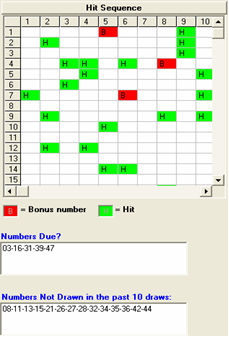
Pressing View from the bar menu and clicking View Hits
the bottom diagram is played to show a over view performance of trend
numbers on how they are doing based on the history of past draws.
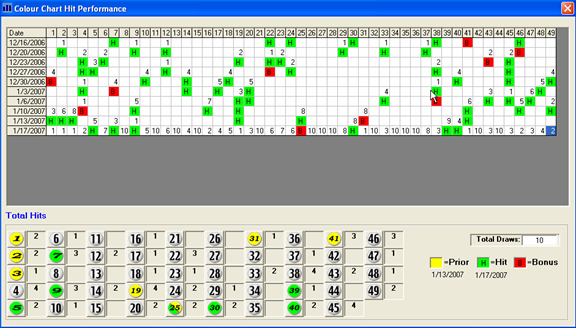
- Colour Chart Hit Performance - This chart is helpful in
determining which numbers to play in the next drawing. For each
number drawn a coloured box is displayed (Green=Hit
and Red=Bonus). Numbers are
displayed prior to hit to show how many times that number has not
been active.
- Total Hits - The bottom view displays how many times a number
has been drawn according to the history of draws displayed.
 |
|
| GRAPH |
|
Having a graph is really easy to see the out come of past winning draws
and it also shows how many times a number has hit. The colour coded bars
tells which numbers are hot or cold and which has hit recently or hit
previously. This display is determined by the Hot Number Cutoff and the
history you are viewing by clicking on the Statistics tab.
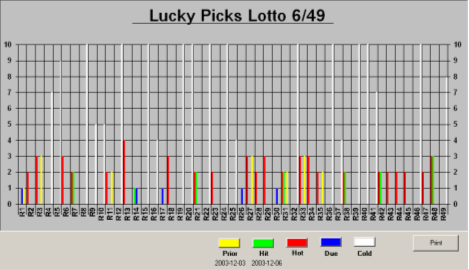
 |
|
|
WHEELING SYSTEM |
Did you know: That there are 13,983,816 different possible combinations in
every Lotto 6/49 draw? That 6,096,454 of those combinations hold none of
the winning numbers, 5,775,588 combinations hold 1 winning number,
1,851,150 combinations hold 2 winning numbers, 246,820 combinations hold
3 winning numbers, 13,545 combinations hold 4 winning numbers, 252
combinations hold 5 winning numbers, 6 combinations have 5 numbers
correct plus the bonus number, and only 1 of those 6/49 combinations
hold all 6 winning numbers.
The Wheeling tab option allows you to do quick picks or wheel selected
numbers according to budget. Also you can customize your wheels but we
recommend you do so with caution and you really have a knowledge of how
it works. Changing wheels can result in poor payouts.
Wheeling Numbers:
Wheeling systems are scientific, mathematical tools. They are numerical
instruments which allow you to give your money more leverage and
dramatically improve your odds over random selection. They are truly a
mathematical breakthrough for the Lotto player! Wheeling systems are an
absolute must for all serious Lotto players!!
Choose a wheeling option
example:
If you where to wheel seven (7) numbers, playing every possible
combination of six numbers, you would have to play seven game panels
because one added number can be combines with all six numbers exactly
seven times, as seen in the columns below.
1 1 1 1 1 1 2
2 2 2 2 2 3 3
3 3 3 3 4 4 4
4 4 4 5 5 5 5
5 5 6 6 6 6 6
6 7 7 7 7 7 7
In this example, the Lotto player has an edge, where as he/she is
playing with seven numbers and if 6 of the 7 numbers possible numbers,
one ticket will hold FIRST PRIZE JACKPOT!
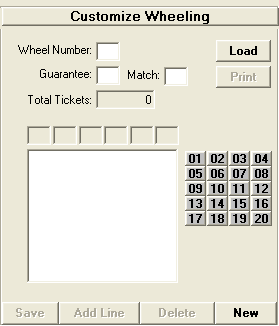
There are lots of wheels to choose from within you budget, or you can
form office pools to increase your odds of winning FIRST PRIZE.
Two choices - Full Wheeling System or Abbreviated Wheeling
System.
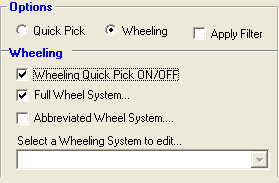
- Full Wheeling System - A full wheeling system generates
all possible combinations of numbers from a defined pool of numbers.
This method can be very costly.
- Abbreviated Wheeling System - An abbreviated wheeling
system generated only some of the possible combinations of numbers
from a pool of play numbers. Consider having ten numbers to play
with. There are 210 different ways of generating six-number sets
from the ten numbers. An abbreviated wheeling system would not
recommend all the 210 games, but would suggest a smaller number of
games to play that would guarantee a least small game prize. This is
the most recommended method to play, which in fact is far less
costly.
What's a "Win Guarantee?" - This guarantee states that if you
have the proper amount of winning numbers in your wheel, you win at a
minimum the prize offered in the wheel's win guarantee. An example would
be a 10 number abbreviated wheel with a win guarantee of 4 of 6 which
requires you to have 4 winning numbers from the 10 number abbreviated
wheel systems. This does not mean that you would not win the jackpot
using this system. This all depends on how many numbers you match the 10
numbers you have selected. Which all so means, even if you have all 10
numbers you could still not win the full jackpot because of the
abbreviated wheel system?
Caution: We strongly urge you not to modify the wheeling
system unless you really have knowledge of how it works. Using a
defective system would result in certain combinations missing out, thus
making the accompanying win guarantee useless.
Wheeling Numbers:
From the Wheeling's tab option from the main display window is the
option to choose Full Wheel system or Abbreviated Wheel system. Once you
generate your wheeling numbers you can also do a history search on those
numbers to see if they have come up in past draws by clicking on the
History tab.
Selecting Numbers:
- From the Options box select type of Wheeling system you are
going to use Full Wheel System or Abbreviated Wheel System.
- For Full Wheel System the selection of dropdown box is disabled.
- From the left selection click on the number of numbers you would
want to use for your Full Wheel System. The maximum selection is 20.
- For Abbreviated Wheel System you must select a pre designed
wheel system from the dropdown box.
- From the left selection click on the number of numbers you would
want to use for your Abbreviated Wheel System.
- From the Select a Abbreviated Wheel dropdown box you must select
the type of wheel system you are going to use according to budget.
This list depends on the number of numbers you would want to use for
your wheel system from the number dropdown list box. The maximum
selection is 20.
- Select the numbers until all the balls are filled in. You can
change this by clicking on the ball then hit the Delete key or
unselecting the number from the selection pad.
- Click on the Wheel button, your numbers for the wheel you chose
would be generated below.
- Click on the Filter, to apply to your numbers for the wheel you
chose for Quick Pick numbers. See Filtering for more detailed
information. Filtering
Selection Pad:
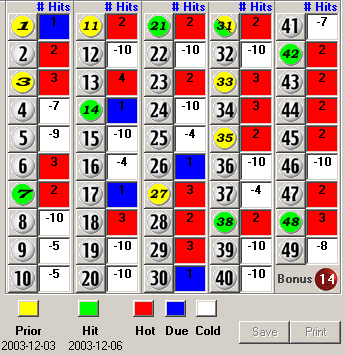
Below is the color coded selection pad for the numbers 1 to 49 for
Lotto 6/49 or Lotto 49 and numbers 1 to 50 for Lotto Max.
Yellow - Previous drawn hit.
Green - Current drawn hit.
Red - Indicates the number is hot according to the Hot
Factor Cutoff point selected from the Static's tab.
Quick Pick Option
The Quick Pick option from the Wheeling's tab option allows the user
to select up to a maximum of 100 quick pick tickets to choose from.
- Click the number of quick picks you wish to play from the
dropdown list.
- Click the Quick Pick button to produce the quick picks. You can
view from the list below.
- Click Clear button to clear the selection box listed below.
- Click on the Wheeling, if you wish to enable options.
- Click on the Apply Filter, if you wish to target certain
numbers.
 |
|
|
SET FILTER |
How to apply a filter:
- Click on the Wheel tab and select how many numbers you want
to play
- Click on View and select View Filter Settings from the
Toolbar
- Select numbers from different areas
- Click on SAVE once Numbers remaining is 0 (zero)
- Click on the Wheel tab and select Quick Pick or
Wheel and click on Apply filter
To apply the filter, select what range or trend of numbers by
clicking on the arrow buttons Up/Down. You will notice on the top
heading "Numbers remaining", that shows how many numbers remaining for
your selection. i.e. Let's take the example below. It shows that the
total numbers selected for our Wheel is 6. Select some numbers from
different areas until the Numbers remaining is 0 (zero). Save your
selection and select Quick Pick/Wheel Button.
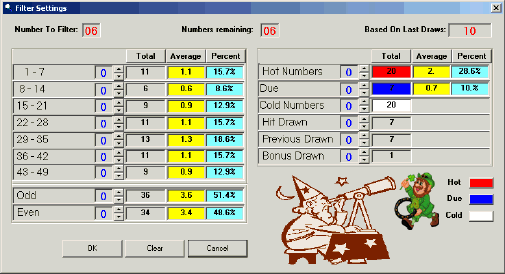
Important: If you change your Wheeling Quick Pick/Quick Pick
quantities you must reselect your filter if you wish to apply the filter
against it.
 |
|
|
PRINTING |
|
Due to many types of printers, the result may be different when it comes
to printing tickets. Not all of the bin options are available on every
printer. The effect of the properties of the Printer object depends on
the driver supplied by the printer manufacturer. The settings may have
no effect or may or may not produce an error. For more information, see
the manufacturer's documentation for the specific driver. For best
results, your printer must have an adjustable manual feeder for the
Lotto ticket sheets which is obtained at any of your lucky Lottery
outlets. Positioning the lotto ticket for example on a HP LaserJet 5si
printer the Lotto ticket sheet should be facing up with the arrow
towards you.
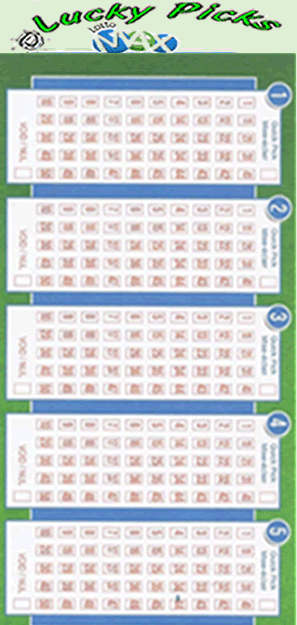 
 |
|
|
BIO-RHYTHM |
History:
Modern biorhythm studies are primarily based on cycles noted by two
researchers in Europe at the close of 19th century and birth of the 20th
century. Between 1897 and 1902 Dr. Hermann Swoboda, a professor of
Psychology at the University of Vienna, recorded the occurrence of
periodicity in fevers, pain and swelling in tissues, heart attacks,
patients' recovery times and several other indicators. He discovered
basic rhythms common to all including the 23 day Physical Cycle and the
28 day Emotional Cycle.
Dr. Wilhelm Flies, a practicing physician in Berlin, was also recording
periodic cycles among his patients and finding the same two rhythms that
Dr. Swoboda had noted. Neither of these gentlemen was aware of the
other's research until some years later when their findings were
published.
In the following years other researchers in Europe and the United States
confirmed the validity of the 23 day Physical Cycle and the 28 day
Emotional Cycle. Two additional cycles have been also been discovered
and studied. These are the 33 day Intellectual Cycle and the 38 day
Intuitional Cycle.
These four cycles; Physical, Emotional, Intellectual and Intuitional;
are considered the Standard or Traditional Cycles. Another group of four
cycles termed the Extended or Esoteric Cycles are based on even earlier
works including the Vedantic records of India and the I Ching of China.
These include the 43 day Aesthetic Cycle, the 38 day Compassion Cycle
(note the congruency with the 38 day Intuition Cycle), the 48 day
Awareness Cycle and the 53 day Spiritual Cycle.
What is Bio-rhythm?
A biorhythm is based on the idea that certain aspects of your life move
in cycles. These being your Physical, Emotional, Intellectual, and
Intuitive well being. The cycle is based on a sine wave, each starting
at 0 on the day of your birth. Each of the different aspects cycles at a
different rate.
Physical cycles once every 23 days - Your vital forces are peaking
when you are in the positive and LOW when you are drained of energy and
vitality.
Emotional cycles once every 28 days - Your emotional forces are
at their best when you are in the positive. Your love life, friendships,
moods and happiness will be at heir high points. Your lack of emotional
energy will slow your reflexes, you'll neglect your love life and
friendships as well as anything concerning feelings when you are at you
LOW state
Intellectual cycles once every 33 days - Your mind will be alert,
you'll find easy to make good decisions, and you'll think creatively in
all areas when you are at your positive state. When you are getting at
your LOWS, you'll forget things, and make all kinds of mistakes, etc. Be
careful what you do during this period. You find yourself hard to
concentrate, study, or absorb difficult information. You'll have to make
a major effort to perform routine intellectual tasks.
Intuitive cycles once every 38 days - Your intuition level is
it's best at high levels, your mind is alert with all your surroundings
making good decisions. You see things be as if it was to happen. Avoid
planning your day when your levels are low.
Where you are in your biorhythm cycles is expressed as a percentage from
-100% to 100%. If you're in the negatives it's not good, obviously.
Bio-Chart Display:
Your Bio-Chart display shows your Bio-rhythm level. Above the display
are selectors for generating either Traditional or Extended charts.
Below the display is a legend showing the chart color used to plot a
cycle. The relative value of each cycle on the selected Report Date is
determined by the markers on the central vertical line. The width of the
chart corresponds to 30 days with the central vertical line indicating
the Report Date. The central horizontal line shows the baseline of each
curve. Active or Positive values are plotted above the baseline and
Passive or Negative values are plotted below the baseline.

Bio-rhythm Info:
Simply point to a name and click on it to select that individual for
bio-rhythm charting. The individual's birth date information appears
below the Name Selector.
Add/Edit/Delete Bio-Data:
- Clicking on the Edit Bio Data button will allow changes.
- To Add a new entry to the database click on the Add button then
type the person's name in First Name Last Name order (i.e., John
Doe). Move down to the Calendar Control Month selector and choose
the Birth day then select the Birth Year. Your new entry will be
added to the bottom of the Names list and also to the Names list on
the main screen. Names will appear alphabetically sorted on the main
screen.
- To Delete an entry from the database point and click on the name
you want to delete then click on the Delete button. The Name List on
the Bio-Data Entry Form and the Name List on the main screen will
both be updated reflecting the change.
Report Date:
The Report Date Selector showing the currently selected Report Date. You
can change the Report Date by clicking on the month, day or year you
wish to view.
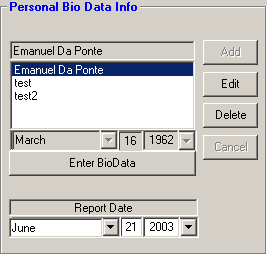
Bio-numbers:
Your bio-numbers will be displayed below according your Bio-info you
have selected. Your bio-numbers is a combination of your bio-data and
Numerology. Check for your lucky numbers when you play Lotto 6/49 or
Lotto 49.

 |
|
| |
| SYSTEM REQUIREMENTS |






















